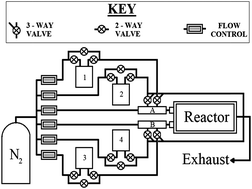A series of Nb, W, N and F:TiO2 thin-film systems were grown by a combinatorial atmospheric pressure chemical vapour deposition (APCVD) process. Conditions were varied in each experiment to produce a series of films with compositional gradient. For each system, the electrical resistivity at a number of positions (up to 200 on each film) was screened using a high-throughput tool. This allowed easy identification of the material with the lowest electrical resistivity across a reservoir of combinatorially produced samples. The most conductive material within each system was analysed in depth by X-ray photoelectron spectroscopy, wavelength dispersive X-ray analysis, X-ray diffraction, Raman spectroscopy, scanning electron microscopy, UV-visible-NIR spectroscopy and Hall effect measurements. The most electrically conductive materials are found in the F:TiO2 [Fs ≈ 4–5%, ρ = 0.21 Ω cm, μ = 3.6 cm2 V−1 s−1, n = 8.1 × 1018 cm−3] and Nb:TiO2 [Nb = 0.07 ± 0.03%, ρ = 0.22 Ω cm, μ = 3.4 cm2 V−1 s−1, n = 8.3 × 1018 cm−3] systems. The electrical resistivities reported for Nb:TiO2 and W:TiO2 are the best to date for materials grown by APCVD. Extensive comparisons with the literature are made and summarised in this report.

You have access to this article
 Please wait while we load your content...
Something went wrong. Try again?
Please wait while we load your content...
Something went wrong. Try again?


 Please wait while we load your content...
Please wait while we load your content...